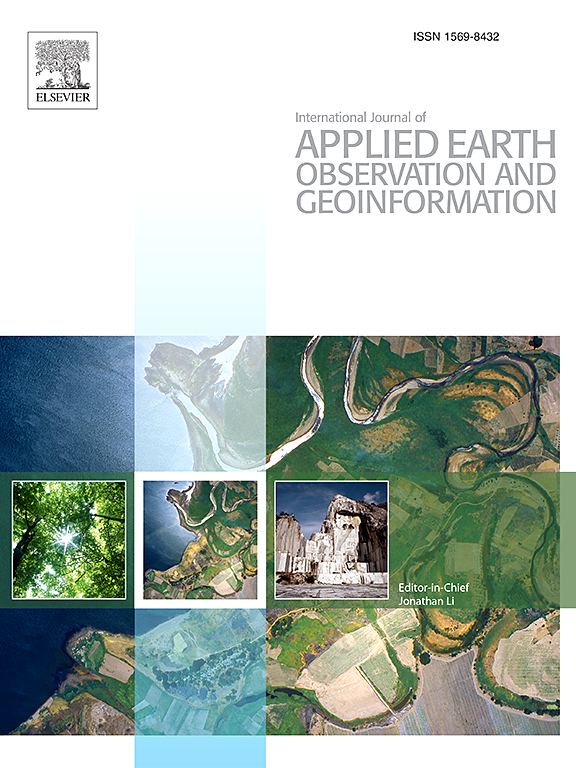BANet:用于在遥感影像和地籍图之间提取变化建筑物的双边关注网络
IF 7.6
Q1 REMOTE SENSING
International journal of applied earth observation and geoinformation : ITC journal
Pub Date : 2025-04-08
DOI:10.1016/j.jag.2025.104486
引用次数: 0
摘要
最新的地籍地图对地方政府管理城市房地产至关重要。遥感图像的可用性越来越高,是更新地籍地图语义内容的经济有效的数据。在本研究中,我们解决了地籍地图上建筑物更新的问题,因为城市更新的主要特征是新建和拆除。虽然以前的工作侧重于从遥感图像中提取所有建筑物,但我们认为这些方法不仅忽略了地籍图上的初步信息,而且无法保留地籍图上未改变区域的建筑物先验。因此,我们将重点放在从遥感影像和地籍图中提取变化建筑(即新建和拆除的建筑)的任务上。为了解决这个问题,我们创建了一个图像-地图建筑变化检测(IMBCD)数据集,该数据集由全球六个不同地理区域的大约27K对遥感图像和地图及其相应的变化建筑组成。因此,我们提出了一个双边注意网络(BANet),引入了一种新的注意机制:改变优先(CF)注意和非改变优先(NCF)注意。这种双边注意机制有助于细化变化和未变化区域之间的不确定区域。在我们的IMBCD数据集上进行的大量实验显示了BANet的优越性能。具体来说,我们的BANet在IMBCD-WHU和IMBCD-Inria数据集上的F1分数分别为90.00%和63.00%,优于最先进的模型。这证实了双侧注意力障碍(BAB)的杠杆作用可以提高表现。本文章由计算机程序翻译,如有差异,请以英文原文为准。
BANet: A bilateral attention network for extracting changed buildings between remote sensing imagery and cadastral maps
Up-to-date cadastral maps are vital to local governments in administrating real estate in cities. With its growing availability, remote sensing imagery is the cost-effective data for updating semantic contents on cadastral maps. In this study, we address the problem of updating buildings on cadastral maps, as city renewal is mainly characterized by new construction and demolition. While previous works focus on extracting all buildings from remote sensing images, we argue that these methods not only disregard preliminary information on cadastral maps but also fail to preserve building priors in unchanged areas on cadastral maps. Therefore, we focus on the task of extracting changed buildings (i.e., newly built and demolished buildings) from remote sensing images and cadastral maps. To address this task, we create an image-map building change detection (IMBCD) dataset, formed by around 27K pairs of remote sensing images and maps and their corresponding changed buildings in six distinct geographical areas across the globe. Accordingly, we propose a Bilateral Attention Network (BANet), introducing a novel attention mechanism: changed-first (CF) attention and non-changed-first (NCF) attention. This bilateral attention mechanism helps to refine the uncertain areas between changed and non-changed regions. Extensive experiments on our IMBCD dataset showcase the superior performance of BANet. Specifically, our BANet outperforms state-of-the-art models with F1 scores of 90.00% and 63.00% for the IMBCD-WHU and IMBCD-Inria datasets. This confirms that the leverage of bilateral attention blocks (BAB) can boost performance.
求助全文
通过发布文献求助,成功后即可免费获取论文全文。
去求助
来源期刊

International journal of applied earth observation and geoinformation : ITC journal
Global and Planetary Change, Management, Monitoring, Policy and Law, Earth-Surface Processes, Computers in Earth Sciences
CiteScore
12.00
自引率
0.00%
发文量
0
审稿时长
77 days
期刊介绍:
The International Journal of Applied Earth Observation and Geoinformation publishes original papers that utilize earth observation data for natural resource and environmental inventory and management. These data primarily originate from remote sensing platforms, including satellites and aircraft, supplemented by surface and subsurface measurements. Addressing natural resources such as forests, agricultural land, soils, and water, as well as environmental concerns like biodiversity, land degradation, and hazards, the journal explores conceptual and data-driven approaches. It covers geoinformation themes like capturing, databasing, visualization, interpretation, data quality, and spatial uncertainty.
 求助内容:
求助内容: 应助结果提醒方式:
应助结果提醒方式:


